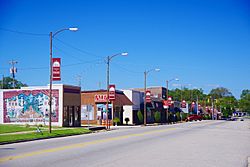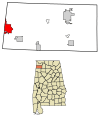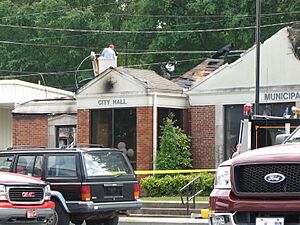Red Bay, Alabama facts for kids
Quick facts for kids
Red Bay
|
||
|---|---|---|

Fourth Avenue
|
||
|
||
| Motto(s):
"A friendly city on a progressive path"
|
||

Location of Red Bay in Franklin County, Alabama.
|
||
| Country | United States | |
| State | Alabama | |
| County | Franklin | |
| Government | ||
| • Type | Municipality | |
| Area | ||
| • Total | 9.84 sq mi (25.49 km2) | |
| • Land | 9.75 sq mi (25.26 km2) | |
| • Water | 0.09 sq mi (0.24 km2) | |
| Elevation | 643 ft (196 m) | |
| Population
(2020)
|
||
| • Total | 3,232 | |
| • Density | 331.42/sq mi (127.97/km2) | |
| Time zone | UTC-6 (Central (CST)) | |
| • Summer (DST) | UTC-5 (CDT) | |
| Zip Code |
35582
|
|
| Area code(s) | 256 | |
| FIPS code | 01-63576 | |
| GNIS feature ID | 0155213 | |
Red Bay is a city in Franklin County, Alabama, United States. It was founded in 1907. Its western edge is right on the border between Mississippi and Alabama. In 2020, about 3,232 people lived there. The city got its name because of the red clay soil and the many redbay trees that grow in this part of northern Alabama.
Contents
History of Red Bay
How Red Bay Started
The area now known as Red Bay was first called "Vinson's Crossroads." It was a little further southwest, near Gum Creek. In 1907, a train track was built through the area. This train line was part of the Illinois Central Railroad.
Because of the railroad, Red Bay quickly grew into an important place for cutting and shipping lumber. The city officially became a town around the same time.
Redbay Trees: A City Feature
One of the most special things about Red Bay is its beautiful redbay trees. The Red Bay Garden Club planted these trees in the 1930s. They now form a lovely green archway over Main Street.
Red Bay High School: A Look Back
The very first school in Red Bay was located where the First United Methodist Church is today. Back in 1903, this school had only one teacher. This teacher taught all the students and also helped clean the school. Students usually went to school after crops were picked in the fall and winter. They would stop attending when it was time for spring planting.
A second school building was built in the early 1900s. It was a small building with few things inside. This school was located where the Red Bay City Park is now. Students still had their school year planned around the local farm harvests.
In 1927, a new school was built for $45,000. This new school was made of brick and shaped like a "U." This was a very popular design for schools in Alabama back then. If you faced the school, the right side of the "U" had the elementary classes. The left side held the high school students. The principal's office was just inside the main entrance, and a small room on the right was the library. A large room in the middle was an auditorium. It had wooden seats that could be folded up and stored away.
Later, more classrooms were added to the left side of the main building. Because the ground sloped, a lunchroom was built at ground level. This was the first cafeteria for Red Bay students.
New Buildings and a Fire
As more students joined, a new high school section was finished in 1962. Then, in 1967, a fire destroyed the auditorium and the elementary part of the 1927 building. Luckily, no one was hurt, even though school was in session. Plans to rebuild started right away. A new auditorium and elementary classrooms were ready for students in the 1968–69 school year.
In 1976, Red Bay celebrated two things: the nation's 200th birthday and the opening of a new gymnasium. Eight years later, in 1984, a new cafeteria was ready. The old cafeteria was changed into five new classrooms, a photography lab, and a room for the yearbook staff.
School Athletics: Red Bay's Sports Teams
Football games were first played in a field where the Sunshine Homes plant is now. Later, games moved to the American Legion Field, which is now the Tiffin Motor Homes location. Red Bay's football team finished second in the state in 1974 and 1976.
The teams had some tough years, but in 1986-87, they won their first game in a long time. Some players from Red Bay even earned scholarships to play at big universities like Alabama and Auburn. One famous player was Van Tiffin. He played for the University of Alabama and made a legendary 52-yard field goal against Auburn. This kick is still famous in Alabama's sports history! Red Bay's football teams reached the state semifinals in 1990, 1997, and 2007.
The Red Bay girls' basketball team has won five state championships! The boys' basketball team made it to the final eight teams in 1995 with a great record of 26 wins and 5 losses. In tennis, Red Bay's highest finish was fifth place in 2008. The Red Bay baseball team was the Class 2A State runner-up in 1987.
City Hall Fire and Rebuilding
In the summer of 2006, the Red Bay City Hall caught fire. This happened after an electrical transformer exploded. Soon after, construction began on a brand new city hall building. The cost for the new city hall was about $750,000. There were also plans for a new police department building, which cost around $500,000.
Geography of Red Bay
Red Bay is located in the western part of Franklin County. Its western edge is right on the border with the state of Mississippi. The city sits on a special dividing line called the Tennessee Valley divide. This means that water in the northern part of the city flows north towards Bear Creek, which eventually goes into the Tennessee River. Water in the southern part of the city flows south towards Gum Creek, which goes into the Tombigbee River.
Alabama State Route 24 is a four-lane highway that runs just south of the city center. If you go east on this highway, you'll reach Russellville about 25 miles away. If you go west, you'll reach the Mississippi state line in about 2 miles. Tremont, Mississippi, is about 18 miles to the southwest.
The United States Census Bureau says that Red Bay covers a total area of about 9.84 square miles (25.5 square kilometers). Most of this area, about 9.75 square miles (25.2 square kilometers), is land. A small part, about 0.09 square miles (0.3 square kilometers), is water.
Population and People
| Historical population | |||
|---|---|---|---|
| Census | Pop. | %± | |
| 1910 | 472 | — | |
| 1920 | 753 | 59.5% | |
| 1930 | 1,297 | 72.2% | |
| 1940 | 1,560 | 20.3% | |
| 1950 | 1,805 | 15.7% | |
| 1960 | 1,954 | 8.3% | |
| 1970 | 2,464 | 26.1% | |
| 1980 | 3,232 | 31.2% | |
| 1990 | 3,451 | 6.8% | |
| 2000 | 3,374 | −2.2% | |
| 2010 | 3,158 | −6.4% | |
| 2020 | 3,232 | 2.3% | |
| U.S. Decennial Census 2013 Estimate |
|||
Red Bay has grown quite a bit since it was founded. In 1910, only 472 people lived there. By 2020, the population had grown to 3,232 people.
Who Lives in Red Bay? (2020 Census)
The 2020 United States census showed that 3,232 people lived in Red Bay. There were 1,220 households and 640 families.
| Race | Num. | Perc. |
|---|---|---|
| White (non-Hispanic) | 2,874 | 88.92% |
| Black or African American (non-Hispanic) | 32 | 0.99% |
| Native American | 23 | 0.71% |
| Asian | 8 | 0.25% |
| Pacific Islander | 2 | 0.06% |
| Other/Mixed | 116 | 3.59% |
| Hispanic or Latino | 177 | 5.48% |
Climate in Red Bay
Red Bay has a "Humid Subtropical Climate." This means it has fairly high temperatures and rain spread out throughout the year. It's usually warm and humid.
| Climate data for Red Bay, Alabama | |||||||||||||
|---|---|---|---|---|---|---|---|---|---|---|---|---|---|
| Month | Jan | Feb | Mar | Apr | May | Jun | Jul | Aug | Sep | Oct | Nov | Dec | Year |
| Mean daily maximum °C (°F) | 9 (49) |
12 (54) |
17 (63) |
24 (75) |
27 (81) |
31 (87) |
32 (90) |
32 (90) |
29 (84) |
24 (75) |
18 (64) |
12 (54) |
22 (72) |
| Mean daily minimum °C (°F) | −2 (29) |
−1 (31) |
4 (40) |
10 (50) |
14 (58) |
18 (65) |
20 (68) |
19 (67) |
17 (62) |
10 (50) |
5 (41) |
1 (33) |
9 (49) |
| Average precipitation mm (inches) | 160 (6.2) |
130 (5.1) |
170 (6.8) |
140 (5.5) |
120 (4.9) |
86 (3.4) |
110 (4.2) |
89 (3.5) |
89 (3.5) |
74 (2.9) |
110 (4.2) |
150 (6.1) |
1,440 (56.5) |
| Average precipitation days | 11 | 9 | 10 | 8 | 8 | 7 | 9 | 7 | 7 | 5 | 7 | 9 | 97 |
| Source: Weatherbase | |||||||||||||
Famous People from Red Bay
Many interesting people have connections to Red Bay:
- Tammy Wynette: Known as the "First Lady of Country Music," she was born nearby and spent time in Red Bay.
- Lindell Cooley: A Christian singer and worship leader.
- Tonya Suzanne Holly: A television and film producer.
- Mac McAnally: A country music singer-songwriter and producer.
- Eric Powell: A member of the Mississippi Senate.
- Van Tiffin: A former American football player who graduated from Red Bay High School. He's famous for kicking a game-winning field goal for the University of Alabama.
- Zadoc L. Weatherford: A former congressman.
- Johnny Mack Morrow: Served in the Alabama Legislature for many years and graduated from Red Bay High School.
- Tiffany McWilliams Dudley: A former professional track and field athlete.
See also
 In Spanish: Red Bay (Alabama) para niños
In Spanish: Red Bay (Alabama) para niños



